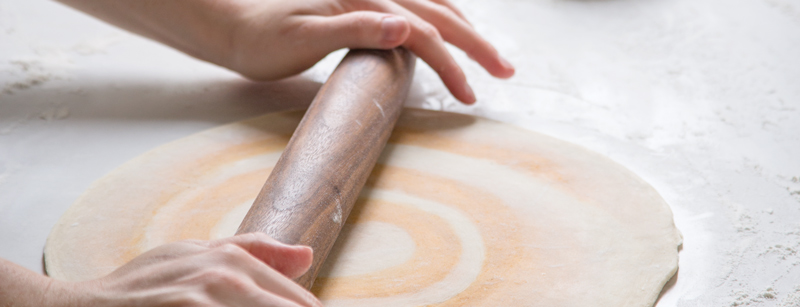The Traditional American Piecrust is the quintessential piecrust. Four simple ingredients—flour, fat, salt, and liquid—fuse to produce a golden, buttery crust with delicate flakes and divine tenderness. Follow our perfect piecrust crash course to ensure your juicy fall pie get’s the flakey foundation it deserves. For our recipe for the Traditional American Piecrust, six fall pie recipes, and our complete guide to pie baking, get our September/October issue!
Know Your Ingredients:
1. Flour is the solid that gives structure to the dough. It’s important to pick flour with a lower protein level, like all-purpose or pastry flour. When you mix water and flour, gluten forms. With less protein, there will be less gluten development and a lighter crust.
2. Fat ensure flakiness by serving as a spacer between layers of dough. The larger the pieces of fat, the flakier the crust becomes. It also keeps the dough tender by coating the flour proteins. There are several fat options—shortening, butter, lard, and oil—and all lend different results. If you choose a solid fat, cold and firm works best! Due to its water content, butter makes the flakiest crust.
3. Salt boosts the flavor by counteracting any bitterness and is a helpful binder for the other ingredients. We like kosher because it’s not as dense as plain table salt and is additive free.
4. Ice Water serves as the binder. When mixed with flour, water gives dough the structure it needs to form gluten and hold together. The amount of water you use is critical. Too much, and your crust will be too tough. Too little, and your crust will be too crumbly. Cold ice water helps the fat remain cold and solid, giving you a more flaky crust.
Mix Your Dough:
You can mix your piecrust dough by hand or with a food processor. We found that using a food processor is not only more efficient, but it keeps the ingredients colder, and therefore, results in a flakier crust. Mixing by hand, however, allows you to monitor the size of the butter pieces in the flour.
Mixing by Hand:

1. Whisk dry ingredients in a large bowl. Using a pastry blender, cut chilled butter into flour. (A pastry blender limits the amount of contact with warm hands.) Gently work butter in with your hands until mixture is crumbly, leaving some of the butter in larger, pea-size pieces.

2. Make a well in the center of mixture, and slowly add 1 tablespoon (15 grams) ice water at a time to bind the mixture together.

3. Using your fingers, stir, toss, and massage mixture until it comes together and forms a dough.
Using a Food Processor:
This is how your dough will look once mixed in a food processor. The dough may appear crumbly. It should be moist and hold together when squeezed, without being sticky.

Troubleshooting Common Pie Problems:
1. Your dough is too dry. If your dough crumbles and breaks when you roll it out, sprinkle some cold water over the dough and gently work it in with your fingers. If your dough gets too warm, refrigerate it for 15 minutes before you try to roll it out again.
2. Your dough is too sticky. First, make sure your oven is off. You want everything to be cold, including the room and the counter. Remember to gently rotate your dough each time you go over it with the pin to keep it from sticking to the surface. If it won’t turn, carefully lift it up, and add a little more flour on the surface.
3. Your piecrusts tend to have soggy bottoms. Brush your prepared dough with egg white or melted butter, and chill before adding the filling. This creates a barrier between the filling’s moisture and the crust.






After I ask my love to marry me. when we get married and have babies we will celebrate by making this pie crust. SALUDE.